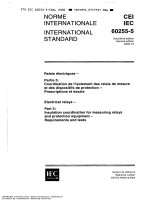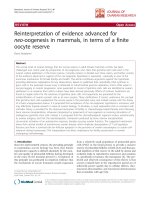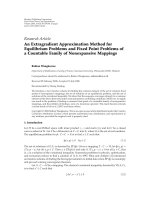Electrical installation calculations advanced for technical certificate and NVQ level 3 by a j watkins; c kitcher
Bạn đang xem bản rút gọn của tài liệu. Xem và tải ngay bản đầy đủ của tài liệu tại đây (2.05 MB, 218 trang )
Electrical Installation Calculations: Advanced
This page intentionally left blank
Electrical
Installation
Calculations:
Advanced
FOR TECHNICAL CERTIFICATE AND
NVQ LEVEL 3
SEVENTH EDITION
A. J. WATKINS
CHRIS KITCHER
AMSTERDAM • BOSTON • HEIDELBERG • LONDON • NEW YORK
OXFORD • PARIS • SAN DIEGO • SAN FRANCISCO
SINGAPORE • SYDNEY • TOKYO
Newnes is an imprint of Elsevier
Newnes is an imprint of Elsevier
Linacre House, Jordan Hill, Oxford OX2 8DP
30 Corporate Drive, Burlington MA 01803
First edition 1957
Fifth edition 1999
Reprinted 2001, 2002, 2003, 2004
Sixth edition 2006
Seventh edition 2009
Copyright © 2009, Chris Kitcher and Russell K. Parton. All rights reserved
The right of Chris Kitcher and Russell K. Parton to be identified as the authors of this
work has been asserted in accordance with the Copyright, Designs and Patents Act 1988
No part of this publication may be reproduced, stored in a retrieval system or transmitted in any form or by any means electronic, mechanical, photocopying, recording or
otherwise without the prior written permission of the publisher
Permissions may be sought directly from Elsevier’s Science & Technology Rights
Department in Oxford, UK: phone (+44) (0) 1865 843830; fax (+44) (0) 1865 853333;
email: Alternatively you can submit your request online by
visiting the Elsevier website at and selecting
Obtaining permission to use Elsevier material
Notice
No responsibility is assumed by the publisher for any injury and/or damage to persons
or property as a matter of products liability, negligence or otherwise, or from any use
or operation of any methods, products, instructions or ideas contained in the material
herein. Because of rapid advances in the medical sciences, in particular, independent
verification of diagnoses and drug dosages should be made
British Library Cataloguing in Publication Data
A catalogue record for this book is available from the British Library
Library of Congress Cataloging-in-Publication Data
A catalog record for this book is available from the Library of Congress
ISBN 978-1-85617-664-4
For information on all Newnes publications
visit our website at www.newnespress.com
Printed and bound in Italy
09 10 10 9 8 7 6 5 4 3 2 1
Malestrom
Contents
Preface
vii
Use of calculators
1
Simple transposition of formulae
3
SI units
5
Conductor colour identification
8
Alternating current circuit calculations
Impedance
Inductive reactance
Capacitive reactance
Impedance in series circuits
Impedance triangles and power triangles
9
9
13
16
20
29
a.c. waveform and phasor representation
Alternating e.m.f. and current
Phasors
43
43
48
Parallel circuits involving resistance, inductance and capacitance
56
Power factor improvement
Calculation without p.f. correction
Calculation with p.f. correction
64
66
66
Three-phase circuit calculations
Star-connected motors
Delta-connected motors (mesh)
Resistance and inductance in three-phase circuits
Three-phase circuits
Three-phase power
Voltage drop in three-phase circuits
70
70
72
74
78
80
85
Contents
Voltmeters and ammeters: changing the use and extending the range
Voltmeters
Ammeters
103
103
105
Alternating current motors
109
Application of diversity factors
116
Cable selection
Earthing conductor calculation
Voltage drop and cable selection calculations
Earth leakage protection calculations
122
122
126
140
Lighting calculations
Units and quantities
Inverse square law
Cosine law
147
147
147
149
Mechanics
Moment of force
Torque
Power
Surface speed, pulley diameter and speed ratios
154
154
154
155
157
Miscellaneous examples
d.c. generators
d.c. motors
Alternators and synchronous motors
Induction motors
Insulation resistance
162
162
163
164
165
166
Formulae
170
Glossary
176
Answers to exercises
180
General questions
192
Additional questions
200
vi
Preface
Mathematics forms the essential foundation of electrical installation work.
Without applying mathematical functions we would be unable to work
out the size of a room which needs lighting or heating, the size and/or the
number of the lights or heaters themselves, the number and/or the strength
of the fixings required, or the size of the cables supplying them. We would
be unable to accurately establish the rating of the fuse or circuit breaker
needed to protect the circuits, or predict the necessary test results when
testing the installation. Like it or not you will need to be able to carry out
mathematics if you want to be an efficient and skilled electrician.
This book will show you how to perform the maths you will need to be a
proficient electrician. It concentrates on the electronic calculator methods
you would use in class and in the workplace. The book does not require you
to have a deep understanding of how the mathematical calculations are
performed; you are taken through each topic step by step, then you are given
the opportunity yourself to carry out exercises at the end of each chapter.
Throughout the book useful references are made to the 17th edition BS 7671:
2008 Requirements for Electrical Regulations and the IEE On-Site Guide.
Electrical Installation Calculations : Advanced originally written by A. J. Watkins and R. K. Parton has been the preferred book for many students looking
to improve their mathematical understanding of the subject for many years.
This edition has been newly updated to the 17th edition IEE Wiring Regulations, not only to include modern methods, but also to cover all aspects of the
new City and Guilds 2330 Certificate in Electrotechnical Technology.
This second volume includes advanced calculations, in particular those
involving cable selection. It will be of considerable use to those already involved in electrical installation work, as well as being invaluable to students
studying the City and Guilds 2330 201, 202, 203, and 205 but in particular
the 302, and 303. It will be particularly useful to those studying for the City
and Guilds 2391-10 Inspection and test 2391-20 Design and verification,
as well as the 2382–10 17th edition wiring regulation exams. The book also
contains a variety of questions and answers to help students with the City &
Guilds 2330 GOLA exams.
Chris Kitcher
Use of calculators
Throughout the ‘Basic’ and ‘Advanced’ books, the use of a calculator
is encouraged. Your calculator is a tool, and like any tool practice is
required to perfect its use. A scientific calculator will be required, and
although they differ in the way the functions are carried out, the end
result is the same.
The examples are given using a Casio fx-83MS. The figures printed on
the button is the function performed when the button is pressed. To
use the function in small letters above any button the shift button
must be used.
Practice is important
Syntax error
x2
x3
√
√
3
x−1
Appears when the figures are entered in the wrong
order.
Multiplies a number by itself, i.e. 6 × 6 = 36. On the
calculator this would be 6x2 = 36. When a number
is multiplied by itself it is said to be squared.
Multiplies a number by itself and then the total by
itself again, i.e. when we enter 4 on calculator
x3 = 64. When a number is multiplied in this way it
is said to be cubed.
Gives the number which achieves the total by
√
being multiplied by itself, i.e. 36 = 6. This is said
to be the square root of a number and is the
opposite of squared.
Gives you the number which when multiplied by
√
itself three times will be the total. 3 64 = 4 this is
said to be the cube root.
Divides 1 by a number, i.e. 14 = 0.25. This is the
reciprocal button and is useful in this book for
finding the resistance of resistors in parallel and
capacitors in series.
1
Electrical Installation Calculations: Advanced
EXP
Brackets
The powers of 10 function, i.e. 25 × 1000 =
25 EXP × 103 = 25 000
Enter into calculator 25 EXP 3 = 25 000. (Do not
enter the × or the number 10.)
If a calculation shows 10−3 , i.e. 25 × 10−3 enter
25 EXP −3 = (0.025) (when using EXP if a minus is
required use the button (−))
These should be used to carry out a calculation
within a calculation. Example calculation:
32
(0.8ì0.65ì0.94) = 65.46
Enter into calculator 32 ữ (0.8 ì 0.65 × 0.94)=
Remember, Practice makes perfect!
2
Simple transposition of formulae
To find an unknown value:
• The subject must be on the top line and must be on its own.
• The answer will always be on the top line.
• To get the subject on its own, values must be moved.
• Any value that moves across the = sign must move from above the
line to below line or from below the line to above the line.
Example 1
3×4 = 2×6
3×4 = 2×?
Transpose to find ?
3×4
=6
2
Example 2
2×6
=4
?
Step 1
2×6 = 4×?
Step 2
2×6
=?
4
3
Electrical Installation Calculations: Advanced
Answer
2×6
=3
4
Example 3
5×8×6 = 3×20×?
Step 1: move 3 × 20 away from the unknown value, as the known values move
across the = sign they must move to the bottom of the equation
5×8×6
=?
3×20
Step 2: Carry out the calculation
240
5×8×6
=
=4
3×20
60
Therefore
5×8×6 = 240
3×20×4 = 240
or
5×8×6 = 3×20×4.
4
SI units
In Europe and the UK, the units for measuring different properties
are known as SI units.
SI stands for Syst`eme Internationale.
All units are derived from seven base units.
Base quantity
Base unit
Symbol
Time
Electrical current
Length
Mass
Temperature
Luminous intensity
Amount of substance
Second
Ampere
Metre
Kilogram
Kelvin
Candela
Mole
s
A
m
kg
K
cd
mol
SI-derived units
Derived quantity
Name
Symbol
Frequency
Force
Energy, work, quantity of heat
Electric charge, quantity of
electricity
Power
Potential difference,
electromotive force
Hertz
Newton
Joule
Coulomb
Hz
N
J
C
Watt
Volt
W
V or U
5
Electrical Installation Calculations: Advanced
Capacitance
Electrical resistance
Magnetic flux
Magnetic flux density
Inductance
Luminous flux
Area
Volume
Velocity, speed
Mass density
Luminance
Farad
Ohm
Weber
Tesla
Henry
Lumen
Square metre
Cubic metre
Metre per second
Kilogram per
cubic metre
Candela per
square metre
F
Wb
T
H
cd
m2
m3
m/s
kg/m3
cd/m2
SI-Unit prefixes
Name
Multiplier
Prefix
Power of 10
Tera
Giga
Mega
Kilo
Unit
Milli
Micro
Nano
Pico
1000 000 000 000
1000 000 000
1000 000
1000
1
0.001
0.000 001
0.000 000 001
0.000 000 000 001
T
G
M
k
1 × 1012
1 × 109
1 × 106
1 × 103
m
1 × 10−3
1 × 10−6
1 × 10−9
1 × 10−12
Á
Examples
mA
km
v
GW
kW
6
Milliamp = one thousandth of an ampere
Kilometre = one thousand metres
Microvolt = one millionth of a volt
Gigawatt = one thousand million watts
Kilowatt = one thousand watts
SI units
Calculator example
1 kilometre is 1 metre × 103
Enter into calculator 1 EXP 3 = (1000) metres
1000 metres is 1 kilometre × 10−3
Enter into calculator 1000 EXP −3 = (1) kilometre
1 microvolt is 1 volt × 10−6
Enter into calculator 1 EXP −6 = (1−06 or 0.000 001) volts (note sixth decimal place).
7
Conductor colour identification
Phase 1 of a.c.
Phase 2 of a.c.
Phase 3 of a.c.
Neutral of a.c.
Old colour
New colour
Marking
Red
Yellow
Blue
Black
Brown
Black
Grey
Blue
L1
L2
L3
N
Note: great care must be taken when working on installations
containing old and new colours.
8
Alternating current circuit
calculations
Impedance
In d.c. circuits, the current is limited by resistance. In a.c. circuits, the
current is limited by impedance (Z). Resistance and impedance are
measured in ohms.
For this calculation, Ohm’s law is used and Z is substituted for R
(Figure 1).
U
= I or voltage (U ) ÷ impedance (ohms)
Z
= current (amperes)
Example 1
The voltage applied to a circuit with an impedance of 6 , is 200 volts. Calculate the
current in the circuit.
U
=I
Z
200
= 33.33 A
6
Example 2
The current in a 230 V single phase motor is 7.6 A. Calculate the impedance of the
circuit.
9
Electrical Installation Calculations: Advanced
I
Z
V
Volt drop
Figure 1
U
=Z
I
230
= 30.26
7.6
Example 3
A discharge lamp has an impedance of 265
0.4 A. Calculate the voltage.
Z×I
265×0.4
and the current drawn by the lamp is
= U
= 106 volts
Example 4
The current through an impedance of 32
the impedance.
U = I×Z
= 8×32
= 256 V
10
is 8 A. Calculate the voltage drop across
Alternating current circuit calculations
Example 5
The current through an electric motor is 6.8 A at 230 V. Calculate the impedance of
the motor.
U = I×Z
U
I
230
=
6.8
(Transpose for Z) Z =
= 33.82
Example 6
An a.c. coil has an impedance of 430 . Calculate the voltage if the coil draws a
current of 0.93 A.
U
U
=
=
=
=
I×Z
I×Z
0.93×430
400 V
Exercise 1
1. Complete the following table:
Volts (a.c.)
Current (A)
Impedance ( )
0.1
100
15
15
230
0.5
400
1000
100
0.01
25
0.05
230
180
25
25
2. Complete the following table:
Current (A)
1.92 3.84 18.2
7.35 4.08
8.97
Volts (a.c.)
7.5
230 107
400 235
Impedance ( ) 2.45
12.4 96.3
56
96
11
Electrical Installation Calculations: Advanced
3. Complete the following table:
Impedance ( ) 232 850
0.125
1050 129
Volts (a.c.)
230 400 26.5 0.194
238 245
Current (A)
0.76
0.575
0.0065 0.436
0.056
4. A mercury vapour lamp takes 2.34 A when the mains voltage is 237 V
Calculate the impedance of the lamp circuit.
5. An inductor has an impedance of 365 . How much current will flow when
it is connected to a 400 V a.c. supply?
6. A coil of wire passes a current of 55 A when connected to a 120 V d.c.
supply but only 24.5 A when connected to a 110 V a.c. supply. Calculate (a)
the resistance of the coil, (b) its impedance.
7. Tests to measure the impedance of an earth fault loop were made in
accordance with BS 7671 and the results for five different installations
are given below. For each case, calculate the value of the loop
impedance.
(a)
(b)
(c)
(d)
(e)
Test voltage, a.c. (V)
9.25
12.6
7.65
14.2
8.72
Current (A)
19.6
3.29
23.8
1.09
21.1
8. The choke in a certain fluorescent-luminaire fitting causes a voltage drop
of 150 V when the current through it is 1.78 A. Calculate the impedance of
the choke.
9. Complete the following table:
Volts (a.c.)
Current (A)
Impedance ( )
61.1
2.3
153
4.2
25
25
193
7.35
9.2
25
Plot a graph showing the relationship between current and voltage. From
the graph, state the value of the current when the voltage is 240 V.
10. The alternating voltage applied to a circuit is 230 V and the current flowing
is 0.125 A. The impedance of the circuit is
(a) 5.4
(b) 1840
(c) 3.5
(d) 184
11. An alternating current of 2.4 A flowing in a circuit of impedance 0.18
produces a voltage drop of
(a) 0.075 V
12
(b) 13.3 V
(c) 0.432 V
(d) 4.32 V
Alternating current circuit calculations
12. When an alternating e.m.f. of 150 V is applied to a circuit of impedance
265 , the current is
(a) 39 750 A
(b) 1.77 A
(c) 5.66 A
(d) 0.566 A
Inductive reactance
When an a.c. current is passed through a conductor, a magnetic field
is created around the conductor. If the conductor is wound into a coil
the magnetic field is increased. Where there are significant magnetic
fields in a circuit there is opposition to the flow of current, this
opposition is called inductive reactance. The opposition caused by
inductive reactance is in addition to the opposition caused by the
resistance caused by the wires.
In this section, we will assume that the resistance of the circuits is so
low that it may be ignored and that the only opposition to the flow of
current is that caused by the inductive reactance.
The formula for inductive reactance
is XL = 2 fL (answer in ohms).
Where L is the inductance of the circuit or coil of wire and is stated in
henrys (H), f is the frequency of the supply in hertz (Hz) (Figure 2).
H
I
Figure 2
13
Electrical Installation Calculations: Advanced
Example 1
Calculate the inductive reactance of a coil which has an inductance of 0.03 henrys
when connected to a 50 Hz supply.
XL = 2 fL
= 2×3.142×50×0.03 = 9.42
Example 2
Calculate the inductive reactance of the coil in Example 1 when connected to a
60 Hz supply.
XL = 2 fL
= 2×3.142×60×0.03 = 11.31
It can be seen from this calculation that if the frequency increases the inductive
reactance will also increase.
Example 3
An inductor is required to cause a voltage drop of 180 volts when a current of 1.5 A
is passed through it at a frequency of 50 Hz.
Calculate the value of the inductor:
UL = I×XL (this is Ohm’s law with inductive
reactance instead of resistance)
14
Alternating current circuit calculations
Transposed
U
= XL
I
180
= 120
1.5
XL = 2 fL
120 = 2ì3.142ì50ìL
Transpose
120
= 0.381 H
(2ì3.142ì50)
On calculator enter 120 ữ (2 ì 50) = (answer 0.382 H)
Exercise 2
1. Calculate the inductive reactance of a coil having an inductance of 0.015 H
when a 50 Hz current flows in it.
2. A coil is required to have an inductive reactance of 150
supply. Determine its inductance.
on a 50 Hz
3. Complete the following table:
Inductance (H)
Frequency (Hz)
Reactance ( )
0.04
50
50
50
0.12
0.008
36
4.5
60
57
4. A coil of negligible resistance causes a voltage drop of 98 V when the
current through it is 2.4 A at 50 Hz. Calculate (a) the reactance of the coil,
(b) its inductance.
5. A reactor allows a current of 15 A to flow from a 230 V 50 Hz supply.
Determine the current which will flow at the same voltage if the frequency
changes to (a) 45 Hz, (b) 55 Hz. Ignore the resistance.
15
Electrical Installation Calculations: Advanced
6. Calculate the inductive reactance of coils having the following values of
inductance when the supply frequency is 50 Hz.
(a) 0.012 H
(b) 0.007 H
(c) 0.45 mH
(d) 350 H
(e) 0.045 H
7. Determine the inductances of the coils which will have the following
reactance to a 50 Hz supply:
(a) 300
(b) 25
(c) 14.5
(d) 125
(e) 5
8. The inductance of a coil can be varied from 0.15 H to 0.06 H. Plot a graph to
show how the inductive reactance varies with changes in inductance.
Assume a constant frequency of 50 Hz.
9. A reactor has a constant inductance of 0.5 H and it is connected to a
supply of constant voltage 100 V but whose frequency varies from 25 to
50 Hz. Plot a graph to show how the current through the coil changes
according to the frequency. Ignore the resistance of the coil.
10. Calculate the voltage drop across a 0.24 H inductor of negligible resistance
when it carries 5.5 A at 48 Hz.
11. An inductor of 0.125 H is connected to an a.c. supply at 50 Hz. Its inductive
reactance is
(a) 39.3
(b) 0.79
(c) 0.025
(d) 393
12. The value in henrys of an inductor which has an inductive reactance of
500 when connected in an a.c. circuit at frequency 450 Hz is
(a) 1.77 H
(b) 14 × 106 H
(c) 0.177 H
(d) 0.071 × 10−6 H
Capacitive reactance
When a capacitor is connected to an a.c. supply, the current flow is
limited by the reactance of the capacitor (XC ).
Formula for capacitive reactance XC =
106
2 fC
where C is the capacitance of the capacitor measured in microfarads
( F) and f is the frequency of the supply in hertz (Hz). (It should be
16
Alternating current circuit calculations
C
I
Hz
Figure 3
noted that d.c. current will not flow with a capacitor in the circuit it
will simply charge and then stop.) (Figure 3)
Example 1
Calculate the reactance of a 70 F capacitor to a 50 Hz supply:
XC =
106
2 fC
106
= 45.47
2ì3.142ì50ì70
Enter on calculator EXP 6 ữ (2 ì 50 ì 70) = (answer 45.47).
Example 2
A power factor improvement capacitor is required to take a current of 7.5 A from a
230 volt 50 Hz supply.
Determine the value of the capacitor.
For this calculation, Ohm’s law is used and R is substituted by XC .
Step 1
UC
=
I×XC
230 = 7.5×XC
17









